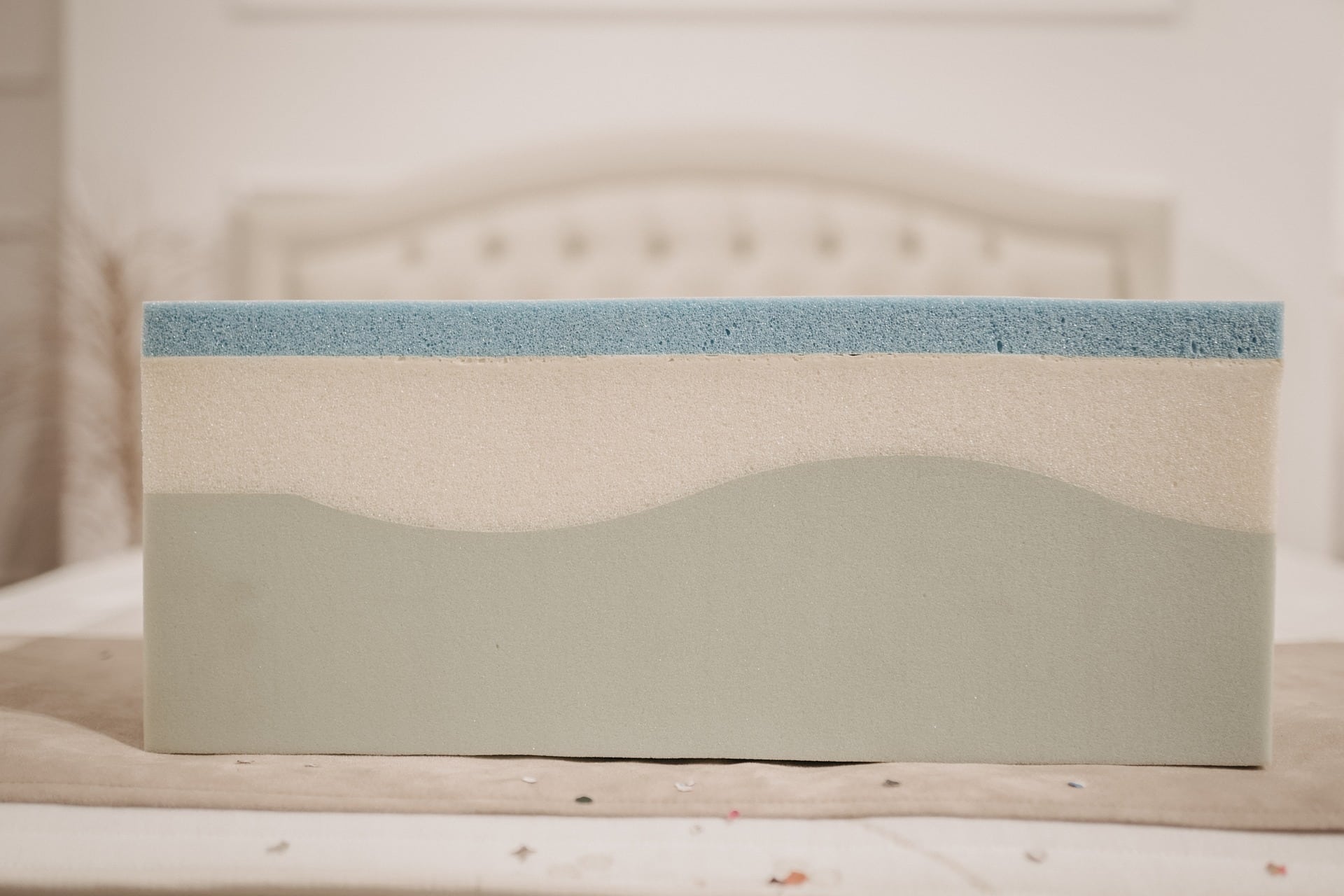What’s the Difference Between Memory Foam and Gel Foam?
In the journey to find the ideal mattress, two types of foam stand out as pillars of modern sleep technology — memory foam and gel foam. It’s essential to not only consider a comparison of materials but also think about how we sleep and what we need for a restful night.
Memory foam, with its rich history dating back to NASA’s ingenuity, and gel foam, a more recent innovation aimed at enhancing comfort, both bring unique qualities to the bedroom. As we explore the differences between these two types of foam, we’ll look at their distinct characteristics and their impact on our sleep quality, health, and overall well-being.
Memory Foam – The Classic Comfort
Before diving into the specific attributes of memory foam, it’s crucial to appreciate its place in the history of sleep technology. Born out of a need for better safety and comfort in aerospace, memory foam has transitioned seamlessly into our homes, offering unparalleled comfort.
Origins and Evolution
Memory foam, initially designed by NASA in the 1960s for airplane seats, has a rich history. Its original purpose was to improve safety and reduce impact during landings. However, its potential in commercial applications, especially in mattresses, was soon realized.
Characteristics and Comfort
Memory foam is celebrated for its viscoelastic properties. It contours precisely to the body, responding to pressure and body heat. This ability to mold to the sleeper’s shape makes it ideal for relieving pressure points and reducing pain in sensitive areas.
Composition and Types
Memory foam is primarily made from viscoelastic polyurethane foam. It comes in various densities and firmness levels, from soft to medium to firm, catering to different comfort preferences.
Some types include traditional memory foam, open-cell memory foam for better breathability, and plant-based memory foam for a more eco-friendly option.
Heat Retention: A Double-Edged Sword
While memory foam’s contouring is beneficial, its tendency to retain heat can be a drawback for some. This warmth is comforting in colder climates but can be less desirable in warmer settings.
Gel Foam – The Cooling Contender
As we turn our attention to gel foam, it’s crucial to recognize it as a response to a specific need within the sleep industry – the need for cooler sleeping surfaces.
Innovative Introduction
Gel foam entered the market as an answer to memory foam’s heat retention issue. Introduced in the 21st century, it is essentially memory foam infused with gel particles to offer a cooler sleeping experience.
Cooling and Comfort
The gel addition helps to disperse body heat more effectively, providing a cooling sensation. This feature is particularly appealing to those who sleep hot or live in warmer climates.
Composition and Varieties
Gel foam is essentially memory foam mixed with gel or gel beads. Types of gel foam vary in gel concentration and distribution, which can influence the cooling effect and firmness of the mattress.
Firmness and Support
In terms of firmness, gel foam tends to be slightly firmer than traditional memory foam, offering more support. This can be beneficial for those needing extra support, such as stomach sleepers or heavier individuals.
Comparing Durability and Maintenance
When comparing the durability and maintenance of these two foams, it’s essential to consider how these factors affect their long-term value and suitability for different sleepers.
Longevity and Lifespan
Both memory and gel foam are known for their durability. However, gel foam might have a slight edge due to its ability to maintain shape and resist body impressions over longer periods.
Maintenance Tips
Proper maintenance is key to extending the life of either mattress. This includes regular rotation, using a suitable base, and protecting it with a mattress cover.
Environmental Impact and Sustainability
The environmental impact of these materials is an increasingly important consideration. As we become more conscious of our ecological footprint, the way these foams are produced and disposed of becomes a crucial factor in our choice.
Manufacturing and Materials
The production of memory and gel foam involves chemical processes, raising environmental concerns. However, strides have been made in recent years, with some manufacturers using eco-friendly materials and methods.
Cost Analysis and Popularity Trends
In understanding the cost and popularity of memory and gel foam, viewing them not just as products but as investments in our health and well-being is essential.
Pricing and Popularity
Memory foam has been a popular choice for decades, offering a range of prices to fit various budgets. Gel foam, a newer technology, tends to be slightly more expensive. However, its growing popularity, especially among those seeking cooler sleeping options, is noteworthy.
Pros and Cons
Here’s a quick overview of the advantages and disadvantages of memory foam and gel foam.
Memory Foam Pros and Cons
Pros
- Excellent pressure relief and body contouring
- Reduces motion transfer, ideal for couples
- Wide range of firmness options
- Good availability and variety in the market
Cons
- Tends to retain body heat
- Sometimes, it emits off-gassing odors
- It can be too soft for some, affecting spine alignment
Gel Foam Pros and Cons
Pros
- Cooler sleeping surface due to gel infusion
- Provides a firmer feel, which can benefit some sleepers
- Good pressure relief, similar to memory foam
- Often more durable and retains shape longer
Cons
- Generally more expensive than traditional memory foam
- The gel can sometimes feel too firm for some users
- Limited availability compared to traditional memory foam
Making an Informed Choice
Choosing between memory foam and gel foam is more than just a matter of preference; it’s about finding the right partner for your sleep journey. With its history of providing personalized comfort and relief, memory foam suits those who value a snug, embracing sleep experience.
Gel foam, on the other hand, offers a refreshing respite for those seeking cooler, more supportive nights. This choice is not just about the materials but about understanding and responding to your body’s unique needs and lifestyle.
Exploring options at Sarasota’s premier sleep boutique can provide you with the opportunity to experience these materials firsthand, helping you make an informed decision. The right choice will be the one that aligns seamlessly with your life, turning every night into an opportunity for rejuvenating, peaceful sleep.







